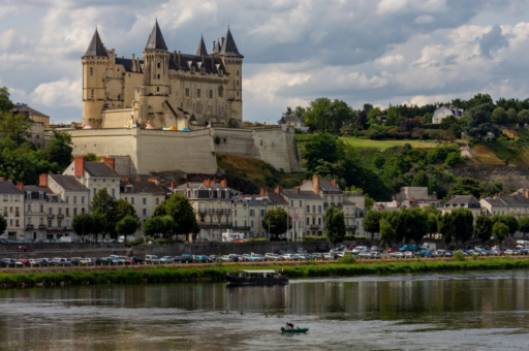Discovering the Troglodyte Villages: A Journey Underground
22 December 2025 by Irina G.Beneath the picturesque landscapes of France's Loire Valley lie hidden gems that offer a unique glimpse into the region's rich history and cultural heritage. Troglodyte villages, carved into the soft limestone cliffs, have been home to residents for centuries, showcasing a sustainable way of living that continues to fascinate visitors from around the world. Join us on a journey underground as we explore the fascinating world of Troglodyte villages, uncovering their past, present, and cultural significance.

Exploring the Underground World: A Guide to Troglodyte Villages
These underground communities, carved into cliffs and rock faces, have been in existence for centuries and provide a rich history to explore. Visitors to troglodyte villages can expect to see a variety of structures, including homes, churches, and even entire villages that have been built into the rock. The intricate architecture and design of these underground dwellings showcase the ingenuity and resourcefulness of the people who once inhabited them. Exploring troglodyte villages allows visitors to step back in time and imagine what life was like for the inhabitants who called these underground spaces home. From narrow passageways to spacious rooms, each structure tells a story of the past and offers a sense of connection to history. In addition to the impressive architecture, troglodyte villages also offer stunning natural surroundings to explore. Many of these villages are located in picturesque settings, with breathtaking views of the surrounding landscape. Visitors can immerse themselves in the beauty of these underground worlds while learning about the sustainable living practices that were employed by the people who lived there. Overall, exploring troglodyte villages is a truly unique and memorable experience. From the fascinating architecture to the rich history and cultural significance, these underground communities offer a glimpse into a world that is unlike any other. Whether you're a history buff, an architecture enthusiast, or simply looking for a one-of-a-kind adventure, a visit to a troglodyte village is sure to leave a lasting impression.Sustainable Living in Troglodyte Villages: Past and Present
These underground communities were built into the natural caves and rock formations, utilizing the earth's natural resources to create a comfortable living environment. In the past, troglodyte villagers relied on the natural insulation provided by the cave walls to maintain a consistent temperature throughout the year. They also made use of organic materials such as straw and mud to build their homes, ensuring minimal impact on the surrounding environment. Water was sourced from nearby rivers and wells, and waste was often composted or used as fertilizer for agricultural purposes. Troglodyte villagers lived in harmony with nature, understanding the importance of preserving the land for future generations. Today, many troglodyte villages have been renovated and modernized, but the core principles of sustainable living remain intact. Residents still use the natural resources available to them, incorporating eco-friendly practices such as rainwater harvesting and solar power. As the world faces increasing environmental challenges, troglodyte villages serve as a reminder of the importance of living in harmony with nature. By looking to the past and learning from the sustainable practices of our ancestors, we can build a more sustainable future for generations to come.Hidden Gems: Must-Visit Troglodyte Villages in the Loire Valley
These hidden gems offer visitors a unique opportunity to step back in time and experience a way of life that has been preserved for centuries. From ancient cave dwellings to stunning underground churches, the troglodyte villages of the Loire Valley are a must-visit for any traveler looking to explore the rich history and culture of this region. Here are some of the top must-visit troglodyte villages in the Loire Valley:Troo: Located on a hilltop overlooking the Loir Valley, Troo is a beautiful troglodyte village that is a true hidden gem. Visitors can explore the winding streets and hidden caves that have been carved into the rock over hundreds of years. Be sure to visit the stunning underground church, which is unlike anything you have ever seen before.
Rochecorbon: This charming village is known for its picturesque troglodyte homes that are built into the cliff face overlooking the Loire River. Visitors can wander through the narrow streets and admire the unique architecture of the cave dwellings. Don't miss the opportunity to sample some of the delicious local wines from the vineyards that surround the village.
Turquant: Situated in the heart of the Loire Valley, Turquant is a troglodyte village that is famous for its thriving arts and crafts scene. Visitors can explore the numerous galleries and workshops that are nestled in the ancient caves, showcasing the work of local artisans. Be sure to pick up a unique souvenir to remember your visit to this special village.
Bourre: This troglodyte village is home to an incredible network of underground tunnels and caves that were once used for quarrying limestone. Visitors can explore the fascinating subterranean world and learn about the history of the village's stone industry. Don't miss the opportunity to visit the stunning Château de Montpoupon, which is located nearby. These are just a few of the must-visit troglodyte villages in the Loire Valley. Each village offers a unique and unforgettable experience that will transport you back in time to a bygone era. Whether you are interested in history, art, or simply exploring the beautiful French countryside, the troglodyte villages of the Loire Valley have something to offer every traveler.